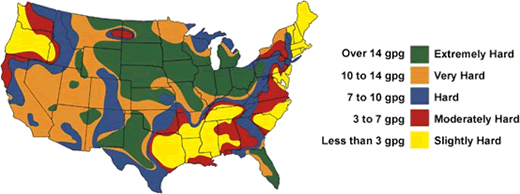At Kasia Organic Salon, owner Kassie, is highly aware of how environmental conditions in their area affect their clients' hair and skin. Over 85 percent of the population in the U.S., according to the Water Quality Association, is bathing with hard water. Hard water is defined as water containing the minerals calcium or magnesium. Most wellness aware salon professions understand these and other minerals are good for their clients to ingest, but these minerals are also the most common cause of salon challenges every single day with every client in many communities.
Your conditions are unique and even within your community; your clients have unique conditions all of which can be understood very simply. Once you understand these conditions, you will have control of every service guaranteed.

A U.S. geological survey study shows that hard water is found in 85% of the United States.
Skin and hair are affected by hard water. A greater amount of shampoo and soap is needed to clean, and hard water doesn't rinse as well as soft water. That means soap residues remain, leaving skin susceptible to blemishes and hair less shiny.
Source: http://www.systemsaver.com
Minerals found in water at home are continuously exposed to hair during bathing. Since hot or warm water is usually selected to wash hair, the cuticle is opened, allowing positively charged elements, such as minerals, to get inside the cuticle and attach to the protein.
Which common minerals affect hair? Calcium, Iron, Copper, Magnesium, Silica, Lead, What is the affect on hair? Calcium is the most wide spread (and usually the most hidden) problem for salons of all the minerals in water throughout the United States.
Mineralized calcium is found naturally in the ground, especially where limestone is present. Calcium (also known as lime) can also be injected into water systems or be used in aqueducts as part of the water treatment/delivery process. When it attaches to hair, it creates an invisible limestone wall on hair and can also irritate skin since it can attach onto body hair. Three ways calcium affects hair:
1. Create a wall that blocks salon chemicals from processing properly. 2. Build-up on the scalp causing flaking, often thought of as dandruff. These deposits are much like the "bathtub ring" associated with hard water and bath soap. 3. Increased hair loss by clogging the mouth of the follicle causing hair to break off and coat the scalp, blocking further hair growth.
Magnesium is usually found wherever calcium comes naturally from the ground. Magnesium is abundant in the soil and is the other mineral that can define water as hard water. Dissolved magnesium solids on the hair or skin can cause the exact same conditions as calcium indicated above.
Iron is considered the biggest challenge by many salon professionals. Clients with iron in their hair are the most difficult hair to process. Iron comes from deep wells underground. Iron will slowly cause hair to tint darker, add weight to the hair, and prevent proper chemical processing. Heavy amounts of iron will tint light-colored hair orange and cause dark hair to become darker with red, brassy overtones.
Oxidized iron actually functions as an oxidizer in hair in much the same way that mild peroxide attacks the hair. It can cause an excessive dry feeling in the hair and may actually change the textural appearance of the hair. As with other minerals, iron can contribute to hair loss, scalp issues and skin irritations.
Copper discolors hair causing blonde hair to turn green and dark hair to tint darker. Chlorine is not what causes green hair, it is copper. Copper can weigh hair down and cause dryness, inhibit the proper processing of perms, color and relaxers, and as with the other minerals, contribute to hair loss and possibly flaking of the scalp, especially since it is usually found where calcium is present. Together, they are trouble-makers for the hair and skin.
Silica is a sand-like substance found in areas of volcanic or desert-like areas. Usually bound to calcium or magnesium, silica forms a very hard wall on hair. Water borne silica can build up on the hair, causing the same effect as calcium.
Lead water pipes are still found in old buildings. Also, lead acetate is used in popular salon and home-remedy products to cover gray. If peroxide is used on hair with lead, it can appear to smoke or turn black. It Is Impossible to have successful services on hair that has lead. Lead will also cause hair to feel dry and prevent the proper processing of perms, color, and relaxers.
Most of the newer technologies are found in products that use freshly activated vitamins, food grade chelators and positive charged proteins. These ingredients replace the old chemical clarifiers that stripped hair attempting to remove minerals and are now recognized as a harsh and unsuccessful approach.
Resource: Malibu Wellness